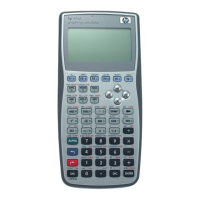RPL Programming 1-13
You can use NOT as a prefix function in algebraics. For example, 'NOT Z‰4' NUM returns 0. if Z =2.
Testing Object Types
The TYPE command (!°%TEST% L %TYPE%) takes any object as its argument and returns the number
that identifies that object type. For example, "HELLO" TYPE returns 2, the value for a string object. See the
table of object types in chapter 3, in the TYPE command, to find
hp49g+/hp48gII objects and their
corresponding type numbers.
Testing Linear Structure
The LININ command (!°%TEST% !«%LININ%) takes an algebraic equation on level 2 and a
variable on level 1 as arguments and returns 1. if the equation is linear for that variable, or 0. if it is not. For
example, 'H+Y^2' 'H' LININ returns 1. because the equation is structurally linear for H. See the LININ
command in chapter 3 for more information.
Using Conditional Structures and Commands
Conditional structures let a program make a decision based on the results of tests.
Conditional commands let you execute a true-clause or a false-clause (each of which are a single command or
object).
These conditional structures and commands are contained in the PRG BRCH menu (!°%BRCH%):
! IF … THEN … END structure.
! IF … THEN … ELSE … END structure.
! CASE … END structure.
! IFT (if-then) command.
! IFTE (if-then-else) function.
The IF … THEN … END Structure
The syntax for this structure is
! «!…!IF!test-clause!THEN!true-clause!!END!…!»
IF … THEN … END executes the sequence of commands in the true-clause only if the test-clause evaluates to
true. The test-clause can be a command sequence (for example, A B ‰) or an algebraic (for example,'A‰B').
If the test-clause is an algebraic, it's automatically evaluated to a number — you don’t need " NUM or EVAL.
IF begins the test-clause, which leaves a test result on the stack.
THEN removes the test result from the stack. If the value is nonzero, the true-clause is executed — otherwise,
program execution resumes following END. See "Conditional Examples" on page 1-15.
To enter IF … THEN … END in a program:
! Press !°%BRCH% !%IF% .
The IFT Command
The IFT command takes two arguments: a test-result in level 2 and a true-clause object in level 1. If the test-
result is true, the true-clause object is executed — otherwise, the two arguments are removed from the stack. See
"Conditional Examples" on page 1-15.
To enter IFT in a program:
! Press !°%BRCH% L!%IFT% .

